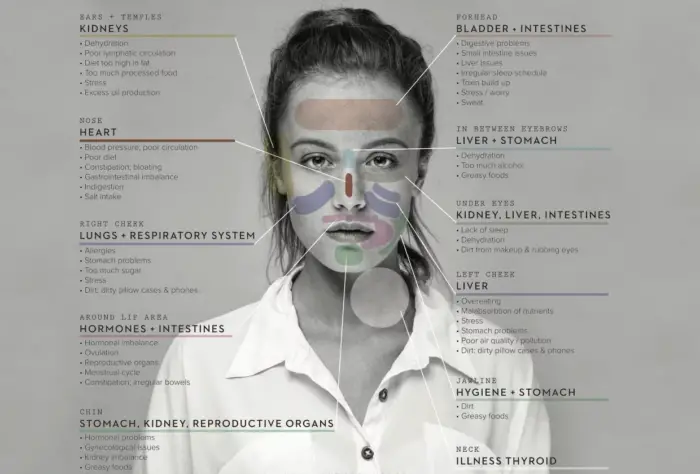Chinese face mapping, also known as face reading or facial diagnosis, is an ancient practice rooted in Traditional Chinese Medicine (TCM). It offers valuable insights into the connection between facial features and overall health, allowing individuals to identify and address specific skin issues through a holistic approach.
With a rich history spanning thousands of years, Chinese face mapping has become a popular tool for promoting skin health and achieving balance in the body.
The Historical Roots of Chinese Face Mapping
The historical roots of Chinese face mapping can be traced back thousands of years to ancient China. The practice is deeply rooted in Traditional Chinese Medicine (TCM), which encompasses a holistic approach to health and well-being. Chinese face mapping, also known as face reading or facial diagnosis, has its origins in the ancient medical texts of TCM.
One of the fundamental texts that contributed to the development of TCM is the Huangdi Neijing, or the Yellow Emperor’s Inner Canon. This work, believed to have been compiled around the 2nd century BCE, serves as a comprehensive guide to Chinese medicine. It covers a wide range of topics, including anatomy, physiology, pathology, diagnosis, and treatment methods.
Within the Yellow Emperor’s Inner Canon, the concept of meridians and the connection between the face and internal organs are introduced. The meridian system is a network of energy channels that flow throughout the body, and it is believed to be responsible for maintaining balance and health.
According to TCM, each organ in the body is associated with specific meridians, and these meridians can be accessed and assessed through various points on the face.
The Chinese have long observed that the face reflects the overall state of health and can provide valuable insights into the condition of the internal organs. This belief forms the basis of Chinese face mapping.
By examining the facial features and noting any abnormalities, practitioners can identify potential imbalances or disharmonies within the body.
Chinese face mapping is rooted in the principles of yin and yang, which represent opposing but complementary forces in the universe. These forces are in constant interaction and are reflected in the human body.
The face is considered a microcosm of the entire body, with different areas corresponding to specific organs or systems.
For example, the forehead is associated with the digestive system and the bladder, while the area between the eyebrows is linked to the liver and gallbladder. The nose is believed to reflect the heart and cardiovascular system, while the cheeks are associated with the lungs and respiratory system. The chin and jawline are connected to the kidneys and hormonal balance.
By analyzing the appearance of the skin, such as acne, redness, dryness, or inflammation, practitioners can gain insights into the underlying imbalances within the corresponding organs. This information is then used to develop treatment plans that address the root causes of skin issues and promote overall health and well-being.
Over the centuries, Chinese face mapping has evolved and incorporated various other elements of TCM, including acupuncture, herbal remedies, and dietary adjustments. Today, it continues to be practiced and valued as a complementary diagnostic tool alongside modern medical practices.
It is important to note that Chinese face mapping is not a standalone diagnostic method. It is most effective when combined with other diagnostic techniques and used in consultation with qualified TCM practitioners or healthcare professionals who have expertise in this area.
By combining ancient wisdom with modern knowledge, Chinese face mapping offers a holistic approach to understanding and maintaining skin health.
How Chinese Face Mapping Works
Chinese face mapping is based on the belief that each area of the face corresponds to a particular organ or system in the body. By analyzing the appearance of the skin, such as acne, redness, dryness, or inflammation, one can identify the underlying organ or system that may be out of balance.

Here is a brief overview of the main areas of the face and their corresponding organs:
Forehead
- Linked to the Digestive System, Bladder and Intestines
- Consume More Chia seeds + Probiotic foods, Cranberry/ D-Mannose
- Avoid Coffee/Carbonation
Between the Eyebrows
- Associated with the Liver and Gallbladder
Consume Chanca Piedra(Stone Breaker), Milk Thistle tea - Avoid alcohol
Nose
- Connected to the Heart, Cardiovascular system and Pancreas
- Consume Black seed oil, Hawthorn Tea
- Reduce Saturated Fat/Cholesterol
Cheeks
- Reflect the Stomach, Lungs and Respiratory System,
- Eat More Fibrous Foods, Drink Mullein Leaf Tea
Chin and Jawline
- Linked to the Kidneys, Sexual Organs and Hormonal Balance
- Consume Dandelion Root, Nettle, Schissandra, Maca, Horny Goat Weed
- Avoid Processed Foods
- Reduce Saturated Fat/Cholestrol
By examining these areas and the specific symptoms or blemishes present, one can gain insights into the potential root causes of skin issues. For example, acne on the forehead may indicate digestive problems or bladder issues, while blemishes on the chin may suggest hormonal imbalances.
Resolving Skin Issues Using Chinese Face Mapping
Chinese face mapping offers a holistic approach to resolving skin issues by addressing the underlying imbalances in the body. Here are some steps you can take to promote skin health based on face mapping principles:
- Diet and Nutrition: Adjusting your diet to support the corresponding organs can be beneficial. For example, if you have acne on your forehead, focus on a diet that promotes healthy digestion, such as incorporating fiber-rich foods and reducing processed foods.
- Lifestyle Modifications: Make lifestyle changes that support overall well-being. This may involve managing stress levels, practicing regular exercise, getting sufficient sleep, and avoiding excessive alcohol and tobacco consumption.
- Herbal Remedies: Traditional Chinese Medicine utilizes various herbs and natural remedies to restore balance in the body. Consult with a TCM practitioner or herbalist to determine the most suitable herbal remedies for your specific condition.
- Acupuncture and Acupressure: These therapeutic techniques stimulate specific acupoints to promote energy flow and balance within the body. Seek the guidance of a qualified acupuncturist to target the relevant meridians associated with your skin issues.
- Facial Care: Tailor your skincare routine based on the needs of specific facial areas. Use non-comedogenic products, keep your skin clean, and ensure proper hydration. Adjust your routine according to the principles of Chinese face mapping.
Conclusion
Chinese face mapping is a fascinating practice that offers a unique perspective on skin health and overall well-being. By understanding the interconnectedness of our facial features and internal systems, we can address skin issues from a holistic standpoint.
Through diet, lifestyle modifications, herbal remedies, and targeted therapies like acupuncture, Chinese face mapping empowers individuals to achieve balance, harmony, and radiant skin.
Embracing the wisdom of Chinese face mapping, in conjunction with modern medical knowledge, can pave the way for a holistic approach to skincare and improved overall health. Remember, the path to healthy skin begins with understanding and nurturing the intricate balance within our bodies.
Improve Your Skin Naturally With Radiate 21 – Click Here To Learn More





